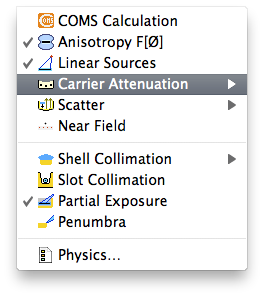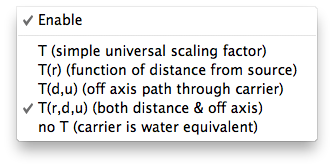
Carrier attenuation correction should be included in dose calculations when the density or atomic composition of the seed carrier differs significantly from water. The COMS plaques use a Silastic silicone carrier. The Silastic material is about 40% Si by weight and has an effective Z of about 10.7 compared to 7.4 for water.

- Enable - Enables dosimetric corrections for the COMS plaque Silastic carrier. Important: Scatter and flourescence correction are already included in the carrier factor for COMS plaques that use a silicone carrier because the flourescence from the gold is absorbed in the silicone. Thus, for a COMS plaque that uses a silicone carrier, the carrier factor should be enabled, and the scatter & flourescence factor B(r) factor should be disabled. For plaques that do not use a seed carrier and for a COMS plaque that uses a gold insert instead of silicone, carrier corrections should be disabled, and the scatter & flourescence factor B(r) factor should be enabled.
- T - The carrier correction factor T is simply a scalar, typically about 0.9 for central axis distances out to about 1 cm (Sou-Tung Chiu-Tsao et al, Dosimetry for I-125 seed (model 6711) in eye plaques, Medical Physics 20(2), 383-389, 1993) for the COMS carriers, which is universally applied without regard to the location of the dose calculation point.
- T(r) - The correction factor T varies as a function of the distance r between the source center and the calculation point.
- T(d,u) - A ray is cast from the center of each source towards the dose calculation point to estimate the primary path length d in the Silastic carrier. The factor u is a linear attenuation coefficient for the carrier material (roughly 0.1 per mm for Silastic) which accounts for the difference in attenuation in Silastic vs water.
- T(r,d,u) - Corrections for both total distance and path length in Silastic are applied (Astrahan M., Improved treatment planning for COMS eye plaques, International Journal of Radiation Oncology, Biology, Physics, 61(4):1227-1242, 2005).
- no T - The carrier is considered water equivalent.